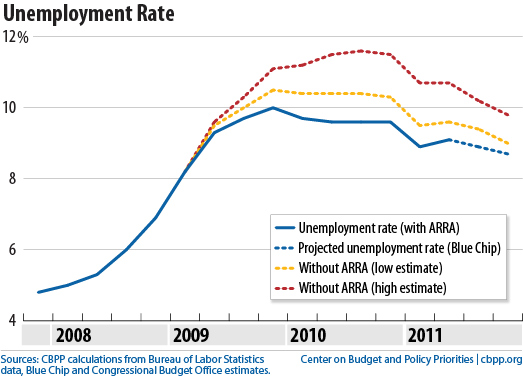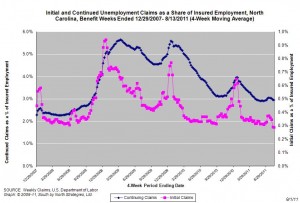02.09.2011
News Releases, Policy Points
CHAPEL HILL (September 2, 2011) – In August, the American economy added no more payroll jobs than it lost. While the private sector netted 17,000 positions, the public sector shed 17,000 jobs, resulting in a net gain of zero jobs. Also in August, 9.1 percent of the labor force was unemployed, while the underemployment rate ticked up to 16.2 percent. These findings come from today’s national employment report.
“The August employment report shows that the national labor market has stalled,” said John Quinterno, a principal with South by North Strategies, Ltd., a research firm specializing in economic and social policy. “Job growth was nonexistent and joblessness remained widespread, as 25.4 million Americans reported being unemployed or underemployed.”
In August, the nation’s employers added no more payroll positions than they cut. A net loss of 17,000 public-sector jobs canceled out a meager gain of 17,000 private-sector jobs. Local government reductions (-20,000, linked primarily to a loss of 13,700 positions in local government education) drove the public-sector decline. In recent months, public-sector cuts have weighed down job growth. Since August 2010, government payrolls have fallen by 450,000 positions with this contraction offsetting 26.3 percent of the private-sector job growth that occurred during the same period.
Furthermore, the payroll employment estimates for June and July underwent downward revisions. With the changes, the economy netted 105,000 jobs over those two months, not 163,000 positions as previously reported.
Several private industries recorded job growth in August. Education and health services added the most positions, (+34,000), followed by professional and business services (+28,000). Information lost the most positions (-48,000), though the number is influenced by the fallout from a large, temporary strike by employees of Verizon Communications. Employment levels in most other major industries were unchanged in August.
“The August employment report is another entry in a series of increasingly weak reports,” noted Quinterno. “Over the past three months, net job growth has averaged just 35,000 positions. The American jobs machine clearly is malfunctioning.”
The inability of the current pace of job growth to alter employment conditions was evident in the August household survey. Last month, 14 million Americans (9.1 percent of the labor force) were jobless and seeking work. While the unemployment rate and number of unemployed individuals dropped over the past year, the share of the population with a job remained depressed. In August, the share of the adult population that was employed (58.2 percent) remained at a level last seen in the early 1980s.
Another cause for concern is the fact that long-term unemployment remains elevated. Last month, 42.9 percent of all unemployed workers had been out of work for at least 27 weeks. A year ago, the comparable figure was 42.2 percent.
In August, proportionally more adult male workers were unemployed than female ones (8.9 percent vs. 8 percent). Similarly, unemployment rates were higher among Black (16.7 percent) and Hispanic workers (11.3 percent) than among White ones (8 percent). The unemployment rate among teenagers was 25.4 percent. Between July and August, unemployment rates for most every major demographic exhibited little change.
Additionally, 7.7 percent of all veterans were unemployed in August. The unemployment rate among recent veterans (served after September 2001) was 9.8 percent.
“Jobs remained scarce in August,” added Quinterno. “This led many individuals simply to abandon their job searches. Compared to a year ago, America has a smaller labor force and more individuals who report being only marginally attached to the labor force.”
A more extensive measure of labor underutilization is the underemployment rate, which equaled 16.2 percent in August. Further evidence of the difficulty in finding a job is that, among unemployed workers, the average time out of work rose in August equaled 40.3 weeks. A year ago, the comparable figure was 33.5 weeks.
“The American economy did not create jobs in August, nor has it managed to create many jobs at all over the past several months. Conditions are not improving, yet policymakers remain strangely passive,” observed Quinterno. “Nothing suggests that a wait-and-see approach will produce outcomes different from those we are seeing.”
02.09.2011
Policy Points
Off the Charts summarizes the recent Congressional Budget Office (CBO) report estimating the impact of the Recovery Act on employment levels. As of the second quarter of 2011, the Recovery Act has increased the number of employed Americans by between 1 and 2.9 million and lowered the unemployment rate by between 0.5 and 1.6 percentage points (see graph, below).

01.09.2011
Policy Points
For the benefit week ending on August 13, 2011, 11,072 North Carolinians filed initial claims for state unemployment insurance benefits, and 108,633 individuals applied for state-funded continuing benefits. Compared to the prior week, there were more initial and fewer continuing claims. These figures come from data released by the U.S. Department of Labor.
Averaging new and continuing claims over a four-week period — a process that helps adjust for seasonal fluctuations and better illustrates trends — shows that an average of 10,781 initial claims were filed over the previous four weeks, along with an average of 109,375 continuing claims. Compared to the previous four-week period, the averages of initial and continuing claims were lower.
One year ago, the four-week average for initial claims stood at 12,699 and the four-week average of continuing claims equaled 133,208.
While the number of claims has dropped over the past year so has covered employment. Last week, covered employment totaled 3.7 million, down from 3.8 million a year ago.
 The graph shows the changes in unemployment insurance claims (as a share of covered employment) in North Carolina since the recession’s start in December 2007.
The graph shows the changes in unemployment insurance claims (as a share of covered employment) in North Carolina since the recession’s start in December 2007.
Both new and continuing claims appear to have peaked for this cycle, and the four-week averages of new and continuing claims have fallen considerably. Also, the four-week average of new claims is now roughly at a level last not seen since October 2008. Yet continuing claims remain at an elevated level, which suggests that unemployed individuals are finding it difficult to find new positions.



 Email Sign-Up
Email Sign-Up RSS Feed
RSS Feed